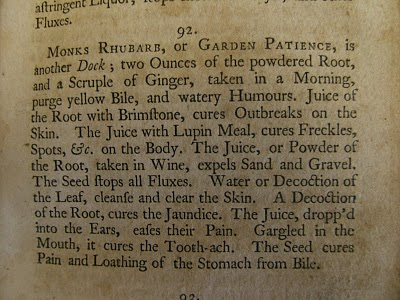Today’s post, on this beautiful, sunny day, is in celebration of Earth Day. Founded 40 years ago, Earth Day was created as a day for us to think about our planet and how we treat it. Here at the Rosenbach we’ve been enjoying our proximity to Rittenhouse square, which is in full bloom. Nature has had a profound effect on artists and writers throughout history, from old favorites like John Muir, Henry David Thorough, Emily Dickinson(some of whose letters we are lending to an exhibit at New York Botanical Garden) and our good friend, Marianne Moore, to contemporary authors, as well. Though Dr. Rosenbach did not collect natural history books in particular, I thought today we could take a peek at some of the items in the Rosenbach collection that describe and illustrate the natural world.
Back when an understanding of botany and geology was a required part of any proper education, there was a market for general natural history instructional books and botanical texts. The demand for practical knowledge of the medicinal properties of plants was one key motivator for the publication of such botanical guides, like “The Youth’s Cabinet of Nature” and Thomas Short’s “Medicina Britannica,” published in 1751.
The “Medicina Britannica” edition we have at the Rosenbach was published in Philadelphia by Franklin and Hall and contains an introduction by noted Philadelphia botanist John Bartram in addition to his notes on similar American plants. If you’re near Philadelphia, you can visit Bartram’s Garden to learn more about Bartram’s role as the father of American (Linnean) botany.
 An excerpt from Medicina Brittanica, A 751m. Searching for a cure for freckles? Look no further!
An excerpt from Medicina Brittanica, A 751m. Searching for a cure for freckles? Look no further!
Poets and writers often look to nature for inspiration and use precise description and specificity to great effect. The Marianne Moore collection at the Rosenbach includes more than just her papers and personal library. Much of Moore’s memorabilia (she was quite a collector) has become part of the Rosenbach’s collection and was featured in the artist’s project by Sue Johnson that will be on display until June. Some shells in Marianne Moore’s shell collection. 2006.4137.002-060
Some shells in Marianne Moore’s shell collection. 2006.4137.002-060
Speaking of Moore, I would be remiss not to bring up one of her most-quoted lines. In her poem, “Poetry,” she wishes for poets who can create “imaginary gardens with real toads in them.” There are many interpretations of this poem, but readers have found those lines to be particularly captivating. In some versions of the poem she encloses the phrase with quotation marks, suggesting that she too, may have been quoting another author.
Finally, here is just one of the beautiful hand colored illustrations in the Comte de Buffon’s encyclopedia of the natural world: a toad, for Miss Moore. This encyclopedia was a massive undertaking of 56 volumes covering all the creatures Buffon could think to incorporate. He was in charge of the project but sadly died before its completion. Our edition is unique in that it shows the engraved plates in avant-lettre state and then in their completed and hand-colored form. I think the illustrations are the best part of these books, but my then again my French isn’t good enough to really judge the text. They’re a real treasure of the Rosenbach collection, so come visit us to check out the whole series!
Also of note: either today or tomorrow is Vladimir Nabokov’s birthday (depending on how you interpret the Julian/Gregorian calendar difference). Nabokov was a distinguished taxonomist and contributed greatly to the field of lepidoptery with his work at the Museum of Comparative Zoology at Harvard. If you go with the 23rd as his birthday, then he also shares it with Shakespeare and Cervantes, two authors featured prominently in the Rosenbach collections. In Barcelona, this coincidence is commemorated with the “Diada de Sant Jordi” or “St. George’s Day” and it is customary to present those you love with a book and a rose. A perfect holiday for book lovers everywhere- enjoy!
Interested in learning more?
… on John Josslyn: two articles found here and here. … on Bartram and Bartram’s Gardens. … on Nabokov at the Museum of Comparative Zoology: an article in The Atlantic.
… on Emily Dickinson: her poem from Part II: Nature, LVII.




